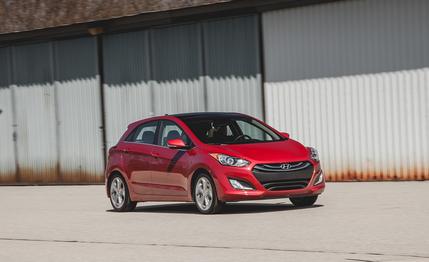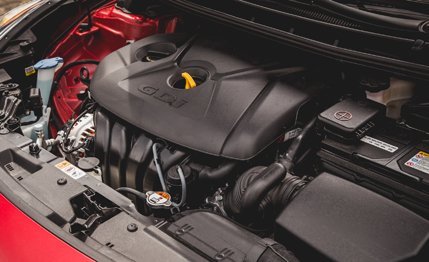 Instrumented Test
Instrumented Test
At one point, the letters GT stood for gran turismo and were attached to cars that weren’t quite suitable for racing but were fast and stylish nonetheless. They usually had two doors, seating for four in a two-plus-two layout, and elegant interiors. A number of James Bond DB-series Aston Martins come to mind, as do a number of Ferraris, Maseratis, and Alfas.
However, the designation has since become so widely and indiscriminately applied as to have lost all distinction. As evidence, consider the Hyundai Elantra GT. Updated for 2014, it employs the same front-drive powertrain as does the rest of the Elantra lineup, which means performance that’s more or less average among compacts.
The hatchback is the only Elantra body style allowed to wear GT badges, and from a visual point of view, it is indeed a distinction versus its lineup-mates. There are subtle suspension distinctions from most other Elantras, too, which you can read about below. (A similar setup is now available in the sedan and coupe’s new Sport trim, which came online as part of a full 2014 refresh.)
MOAR POWER
The 2014 GT joins other Elantras in adopting a new 2.0-liter twin-cam four with variable valve timing and direct injection. It generates 173 horsepower and 154 lb-ft of torque. The numbers don’t look robust compared with some other cars seen in this size class—the turbocharged Ford Focus ST packs 252 hp and 270 lb-ft—but they’re not bad among naturally aspirated powerplants of similar displacement. And they’re big jumps over those of the Elantra GT we tested in 2013, which featured a port-injected 1.8-liter four making 148 horsepower and 131 lb-ft.

That previous GT, which had the six-speed manual, took 8.3 seconds to hit 60 mph and 16.5 to cover the quarter-mile. Our 2014 GT test car was heavier—3029 pounds versus 2949—but it did manage to trim almost a half-second off that earlier 0-to-60 time and covered the quarter in 16.1 seconds.
The improved performance comes in spite of our test car’s automatic transmission, which offers manual shifting if you tilt the lever fore or aft (there are no paddles), but the upshifts are sluggish. Downshifts are a little more vigorous, but this is not a setup that’s likely to satisfy anyone who actually enjoys driving. This absence of a GT-style driver reward also applies to the exhaust note. It’s subdued in subdued motoring but becomes slightly asthmatic when the engine is pressed toward its power peak.
Fuel-economy projections for the new engine rate a mention. Although increased displacement and higher output generally aren’t conducive to improved mpg, you might expect those changes to be mitigated by the addition of direct fuel injection. Nope. Our 2013 Elantra GT was rated by the EPA for 26 mpg city and 37 highway, the 2014 at 24/33. We did do better by our own records, however, managing 26 mpg in this latest test versus 23 for the 2013 model. We put that down to the lower fun factor of the automatic.

Zigs, Zags, and Zzzz
As a device for negotiating decreasing-radius corners and straightening out a series of ess bends, the new Elantra GT measures up a little better. The structure is solid, and there’s more roll stiffness than that displayed by the other models, which makes sense, as the hatchback has different dampers, somewhat firmer springs, and a slightly stiffer rear torsion beam. The electric rack-and-pinion steering is surprisingly precise, if not very feelsome. (The steering has three settings that alter weight but not much else; put it in Sport and leave it there.) That the car pulled 0.83 g on the skidpad was a pleasant surprise, given its Nexen Premiere all-season tires (215/45-17). The tires’ contact patches are adequate and their profiles low, reducing sidewall flex, but these are a long way from Michelin PS2s or Pirelli P Zeros.